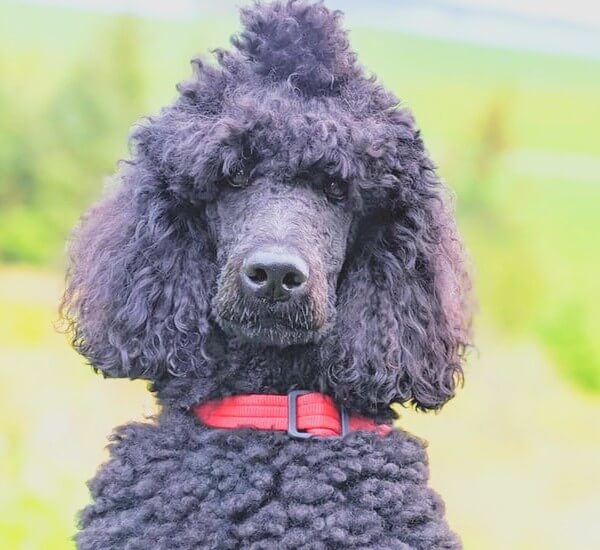
If you’ve heard of the Blue Poodle, you’re probably wondering what’s so special about these dogs. There’s plenty of reasons why the Blue Poodles are special. They are loyal companions with charming demeanor. They catch your eyes with their various coat colors.
But are Blue Poodles really blue? In this article, we’ll discuss everything you need to know about the Blue Poodle and dig deep into this blue spectrum. Let’s begin!
Table of Contents
What is a Blue Poodle?

A Blue Poodle has a greyish-blue hue on its body, undercoat, and some of its head fur. In this article, we’ll see how the color appears, its genetics, and the difference between blue and other similar colors.
But first, let’s try to understand what we mean by a “Blue Poodle.”
What color is a Blue Poodle?

The blue color in canines isn’t like blue paint or the color of the sky. Blue Poodles are naturally blue-black with a hint of grey in their coat.
Sometimes, when these Poodles are young, you can almost mistake them for being chocolate brown. That browning goes away after the pooch reaches adulthood.
Blue vs Silver Poodle
Blue is a diluted shade of black. An all-black dog with the genetics to be a Blue Poodle will have a clear, shiny coat with some flecks of grey on her fur.
You can even see their blue hue when looking at their paw pads or just under their coat.
However, this bluing is gradual, so it is easy to confuse them with the standard Black Poodle until they mature.
Silver is another gene altogether. Silver Poodles have a much lighter coat that resembles grey more than black. Silver Poodles get grey fur much faster than Blue Poodles.
Check out: F1B Bernedoodle (Complete Guide)
What is a Blue standard Poodle?
Poodles come in three sizes:
- Standard.
- Mini.
- Toy.
The Blue Standard Poodle is the largest of the three sizes, which puts them among medium-large dogs. Blue standard Poodles grow to be about 24 inches tall and weigh anywhere from 50 to 70 pounds.
Genetics behind Poodle coat colors
In most other canines, blue coloration results from a dilution gene (b) or greying gene (G) that causes a black coat to become bluish-grey.
It’s not that odd to come across different Blue Poodle colors and shades.
Some Poodles are noticeably bluer, whereas others have a brown hue. Some aren’t that different from black, and you won’t probably notice their dilution.
Here are five factors to consider when it comes to the genetics behind your Poodle’s coat color:
1. Check their nose color
Blue Poodles can have blue or black nose color. If your Poodle has a black nose, that doesn’t mean they aren’t blue. Look for other signs.
2. Check their roots
You will find grey or light-colored fur if you scan a Blue Poodle’s roots.
3. Check their face
Blue Poodles have a greyer face than Black Poodles.
4. Check for browning
Blue Poodle puppies can display a dark brown shade. This browning goes away after they grow up.
5. Get a genetic screening
DNA testing can reveal your Poodle’s true colors, even if they don’t have distinct physical attributes.
What is unique about the Poodle’s coat?
The Poodle has curly or wavy hair that makes it unique amongst other dog breeds. Dense, soft, and puffy hair is this breed’s hallmark. The hair is flexible and can be reshaped into different styles with no difficulty.
Here are four distinctive qualities of the Poodle’s coat:
1. Texture
Poodle hair is soft and dense with tight curls. They can sometimes have long corded coats that give them a mop-like appearance.
2. Shedding
Poodles are famous for their non-shedding coats. They shed very little, and their loose hair stays stuck between their curls until you brush them.
3. Multiple styles
There are about 50 recognized coat clips for Poodles, more than any other dog.
4. Growth
Poodle hair grows rapidly, which is why they need trimming every six weeks.
Poodle Skin Color
Poodle puppies have baby-pink skin, but the skin tone gets darker as they grow older. This phenomenon is perfectly natural, and the gradual darkening of the skin is nothing to worry about.
They can also develop dark patches, which isn’t a cause for concern.
However, it’s best to seek a vet’s opinion if they get too many black spots.
Other Poodle Coat Colors
The Blue Poodle dog is pretty unique, but Poodles come in various beautiful coat colors. Most are solid, but some have more than one color on them.
Other than the Blue Poodle, Poodles also come in the following coat colors:
- Black Poodle.
- White Poodle.
- Brown Poodle.
- Cream Poodle.
- Red Poodle.
- Silver Poodle.
- Café Au Lait Poodle.
- Apricot Poodle.
- Black and Grey Poodle.
- Black and Brown Poodle.
- Black and Silver Poodle.
- Black and white Poodle.
- Black and red Poodle.
- Black and apricot Poodle.
What’s the rarest color of Poodle?
Blue Poodles are rare, but they don’t hold a candle against some even rarer coat colors. Apricot, red, café au lait and sable are some highly unique coat colors for Poodles.
While Poodles mostly come in solid, it’s not odd to find them in two, and sometimes three colors.
The Blue Phantom Poodle is a rare tri-colored Poodle with a blue base coat, white belly and chest, and tan patches on eyebrows and snout.
Poodle coat color changes
Poodles are notorious for their extreme color changes. Some Poodles are born with solid white coats that get darker with age. Most Poodle colors are dark and get fainter with time.
The changes begin slowly and progress steadily to give your Poodle a completely different look.
It isn’t until they are 3 years old that your Poodle’s coat will “settle” into its final color.
Changing color isn’t a set rule, and many Poodle pups do maintain their original color in a phenomenon known as holding.
Here are some ways Poodles change color.
- Silver Poodles start as black and display a rapid greying of their hair, eventually turning silver.
- Café au lait Poodles start as dark brown and lighten until they get a coffee-like color.
- Age-related greying is also a phenomenon observed in Poodles; however, some Poodles also have a greying gene that does that.
- Red Poodles lighten to an almost cream shade known as apricot.
- Blue Poodles start as black and lighten over the next few years before becoming true blue.
What happens when a Poodle turns gray?
Poodles can turn grey with age, or they may have a grey or silver gene causing the color change.
When the grey or silver gene doesn’t fully dominate in Black Poodles, the Poodle gets a slate grey or blue coat.
When the gene is dominant, it can cause the Poodle to show grey hair in specific areas or turn completely silver.
You may be interested in: Grey Pitbull: Complete Guide
Can Poodles have blue eyes?
We know that Poodles can have blue hair, but do Poodles have blue eyes? The short answer is no.
However, there can be instances when a Poodle’s eye color may appear blue. It’s important to note that the American Kennel Club (AKC) doesn’t recognize the Blue-Eyed Poodle.
The reasons behind a Poodle’s blue eyes can be one of the following:
- The merle gene causes blue eyes in Poodles.
- Crossbreeding a Poodle with a blue-eyed breed can give blue-eyed pups.
- Underdeveloped pigmentation in young puppies gives them baby blue eyes that darken with age.
- Albinism is an absence of pigmentation and can cause blue or pink eyes in Poodles.
Blue nose Poodle
Blue nose Poodles are those that carry the dilution gene. Unlike the coat color modifying silver or grey gene, the dilution gene also affects the dog’s nose, lips, paw pads, and eye rims.
Blue Poodle size, height, and weight
Blue Poodles can come in four sizes:
- Toy.
- Miniature.
- Medium.
- Standard.
Here is a chart to compare them all.
Blue Poodle Sizes
| Blue Standard Poodle | Blue Medium Poodle | Blue Miniature Poodle | Blue Toy Poodle | |
| Size group | Medium-large | Medium | Small | Small |
| Height | 18-24 inches | 14-18 inches | 11-14 inches | 9-11 inches |
| Weight | 44-71 pounds | 33-42 pounds | 26-31 pounds | 14-17 pounds |
Blue Poodle temperament and personality
Blue Poodles can be very energetic and playful, but they also have excellent guard-dog skills. They’re known for their loyalty and enthusiasm and consider themselves to be the center of attention.
Fun Fact: The Cane Corso Husky Mix is a great guarding and working dog as well.
Do Blue Poodles get along with other pets?
Although Blue Poodles are very loyal to their owners, they can also get along well with other pets, particularly dogs. Their friendly nature depends on their upbringing, and they don’t play well with other pets unless raised in a multi-pet household.
Blue Poodle training
Blue Poodles need a firm but gentle hand when training. They’re very intelligent and eager to please, so their training sessions will go well.
In fact, it’s easy to overdo the petting, so make sure you don’t give your Blue Poodle too much attention.
Blue Poodle exercise requirement
Blue Poodles love to run and play. They don’t need too much exercise, but they’re happiest when they’re active.
A Blue Poodle that lives a sedentary life can succumb to obesity and develop behavioral issues.
Blue Poodle grooming and cleaning
Blue Poodles are high-maintenance dogs. For their coat to shine, they need regular brushing using a pin or slicker brush. The Blue Poodle should get a haircut once every 6 weeks.
Poodle hair can grow very fast and can become an issue when it comes to hygiene. Trim the hair in your Blue Poodle’s ears regularly to prevent them from collecting wax, dirt, and moisture.
If you want a show-ready Blue Poodle, you should take her to a Blue Poodle pet salon. A professional groomer knows how to groom a Blue Standard Poodle so that she’s ready to enter beauty pageants.
What is a Blue moyen Poodle?
Moyen is French for middle, but in dog terms, it refers to mid-size Poodles. Blue Moyen Poodles grow to about 14 to 18 inches at the shoulder and weigh between 33 to 42 pounds, putting them between standard and miniature Poodles.
Blue Poodle puppies
A Blue Poodle puppy looks no different from a Black Poodle puppy, and they only begin to show their actual color once they grow a bit older.
However, expert dog breeders can use several methods to determine if a Blue Poodle is genuinely blue.
What are the differences between a Black Poodle and a Blue Poodle?
Blue Poodles look a lot like black ones, and it may be difficult for the untrained eye to detect a Blue Poodle unless it is standing beside a Black Poodle.
Blue Poodles have a slate grey or gunmetal coat that distinguishes them from Black Poodles. Their face has a noticeably lighter grey coloring, whereas Black Poodles have the same shade of black all over their bodies.
How much do Blue Poodles cost?
Fortuantely, Blue Poodles don’t cost a lot more than regular Poodles, and you can get your hands around one for as low as $500.
The coat color isn’t the only factor that determines the Blue Poodle’s price, other aspects like parentage, health, age, and size matter as well.
In any case, the most you can expect to pay for a Blue Poodle is $2,000.
Is Blue Poodle hypoallergenic?
It may seem like the Blue Poodle doesn’t shed. This may prompt you to ask, “Are Poodle coats hypoallergenic?”
The answer is yes. These furballs don’t leave their hair around and are pretty safe for people with mild dog allergies.
Blue Poodle food and diet
The optimum food quantity for your Poodle depends on your pup’s size, age, and level of activity. You can always ask a vet or a professional dog feeder for advice.
In any case, your Poodle must get a balanced diet comprising of proteins, vitamins, and some essential minerals.
Blue Poodle common health issues
Poodles are famous for their gorgeous looks and low likelihood of developing major diseases.
However, they aren’t entirely free from health risks. If you own a Blue Poodle or any other color in the breed, you should be on the lookout for the following issues.
1. Bloat
Bloat is when the pooch eats too fast and eats more than can be digested at one time. This results in a rapid and sudden rise of internal pressure, expanding the stomach and intestines.
2. Hyperthyroidism
Hyperthyroidism is a chronic illness that occurs when your dog’s thyroid gland becomes overactive. The symptoms include weight loss, excessive thirst, lots of panting, patchy hair loss, and even seizures.
3. Addison’s disease
Addison’s disease is a severe illness characterized by insufficient production of enzymes by the adrenal gland. It causes adrenal insufficiency, leading to low blood pressure, vomiting, dehydration, loss of appetite, and weakness.
You may also like: Dog Vomit Color Guide
Health problems that affect the Poodles’ Coats
A Poodle’s coat is its most striking feature and one of the reasons why they are so popular. But that coat also requires careful maintenance as it is prone to several diseases.
Here are four health problems thatcan affect your Poodles’ coats.
1. Allergies
Poodles may not trigger allergies in humans, but they have allergies of their own. The symptoms can include inflammation of their skin, intense scratching, and bald patches.
2. Sebaceous Adenitis
The sebaceous gland secretes an oily substance that protects the fur from becoming brittle and dry. In Sebaceous Adenitis, those glands become swollen and inflamed, causing them to produce thinner oil, leading to hair loss.
3. Demodectic Mange
Demodex is a kind of mite that lives in the dogs’ skin. In dogs that are prone to allergies, these mites cause itchy, inflamed skin and hair loss. This condition is called Demodectic mange.
4. Cushing’s Disease
Cushing’s disease is a medical condition characterized by excessive production of cortisol, a hormone that regulates the body’s metabolism. This condition disrupts the natural hormone balance, leading to diabetes, extreme thirst, urination, and hair loss.
Blue Poodle lifespan
Blue Poodles purchased from a reputable breeder typically live between 10 and 18 years.
Blue Poodle adoption
Adoption isn’t just a nobler option; it is also easier on your pocket. The costs associated with Poodles are high since they need special diets and haircare to keep their coat looking gorgeous.
So, if you can, your Blue Poodle will thank you for adopting him or her and adoption can also help you save some money.
Blue Poodle for sale
Valaurah Farms has some exquisite Blue Merle Standard Poodle Puppies for sale.
You can also visit Merle Standard Poodles on Facebook to check out some of their Poodles. They have the Blue Merle Poodle for sale, Blue Teacup Poodle for sale, Blue Standard Poodle for sale, and even a Blue-Eyed Poodle for sale.
Blue Poodle Mix
Several Blue Poodle mixes have similar blueish coat colors. These Blue Poodle mixes — also known as Blue Doodles — are getting increasingly popular due to their hypoallergenic coats.
They also display some desirable characteristics not present in the Poodle breed.
Blue Heeler Poodle mix
Blue Heeler Poodle Mix Puppies are getting increasingly popular. If you want a different color from a regular Poodle, a Blue Heeler and Poodle Mix is the way to go.
Blue Heelers, or Australian cattle dogs, are an intelligent canine breed known for herding cattle in the Australian outback. Mixing them with a Poodle gives you a beautiful and capable dog that is easy to train and has a striking, non-shedding coat.
Blue Heeler Poodle Puppies may resemble a standard Blue Heeler from their coat color, but they have a more Poodle look. Full-grown Blue Heeler Poodle Mix can inherit the floppy ears of the Poodle or sport erect ears of the heeler.
Blue Merle Poodle
Merle is a gene modifier that results in the dilution of pigment in the pooch. This causes white patches to emerge on the dog’s coat alongside its normal color.
Blue merle isn’t a standard Poodle color, and breeders avoid producing it because whether it is a Blue Merle Mini Poodle, Blue Merle Toy Poodle, or Blue Merle Standard Poodle, they are all prone to several health problems that complicate their lives and reduce their lifespan.
RELATED: Merle Poodle – Complete Guide
Is a Blue Poodle right for me?
Blue Poodle is a beautiful dog that loves nothing more than spending time with you. Blue Poodles are a very intelligent breed and can even learn tricks.
However, this kind of pet requires commitment from its owners as the Blue Poodle has high grooming needs. If you have the time and commitment, then the Blue Poodle may be the dog for you.
Related Questions
Yes, Blue Poodles are pretty rare. However, this rarity hasn’t resulted in them getting an overly inflated price tag. Some even rarer colors such as red, Cafe au Lait, sable, and apricot cost much more.
Yes, Blue Poodles exist; however, they aren’t “blue” like the sky. There’s a gene that dilutes pigment, and this causes the Poodle’s black fur to take on a light gray hue. This greyish-black color is what we call blue.
DISCLAIMER: THIS WEBSITE DOES NOT PROVIDE MEDICAL ADVICE
The information, including but not limited to, text, graphics, images and other material contained on this website are for informational purposes only. No material on this site is intended to be a substitute for professional veterinary advice, diagnosis, or treatment. Always seek the advice of your veterinarian or other qualified health care provider with any questions you may have regarding a medical condition.
Resources:
https://en.wikipedia.org/wiki/Poodle
https://www.akc.org/expert-advice/dog-breeds/do-hypoallergenic-dog-exist/

With over five years of specialized experience as an animal writer, my expertise lies in dog nutrition, health, behavior, grooming, and training. I am dedicated to delivering helpful and informative content that caters to the well-being of our furry friends. My primary goal is to empower pet owners with knowledge and ensure our canine companions thrive in health and happiness. In my free time, I love volunteering at local dog rescue centers.







